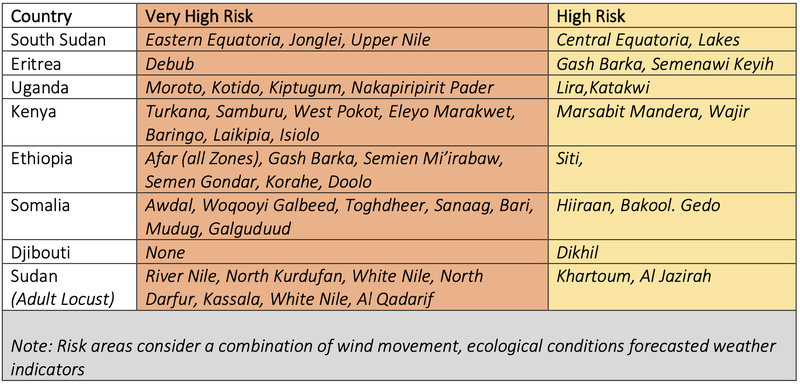Desert Locust Projection October 2020
Very high risk of significant impact to both crops and rangelands due to the high rainfall received in the northern parts of the region which has enabled the swarms to migrate.
Projected impact on food and fodder
- Very high risk of significant impact to both crops and rangelands due to the high rainfall received in the northern parts of the region which has enabled the swarms to migrate. Most agropastoral areas in reproductive stages of crop development have had crops destroyed which will affect crop yield and pasture availability.
- Higher than usual rainfall in Sudan, northern Ethiopia and northern Somalia will continue to cause favourable conditions for locust to continue breeding and develop, thus increasing the numbers of swarms even with control measures being undertaken.
Desert Locust Spread
- In the current desert locust invasion areas of Eastern Africa, locust swarms have been reported in the last 6 weeks in north-western areas of Kenya; northern and north eastern Ethiopia; north-west and north-eastern Somalia. Adult locusts continue to be reported in large numbers in the areas that received high rainfall amounts and which benefit from good vegetation. These are showing high reproduction and rapid development.
- There continues to be large number of swarms even with the ongoing control efforts in both northern Ethiopia and northern Somalia. Multiple parts of Sudan have reported adult locust in the States of Red Sea, Kassala, Northern, River Nile and White Nile.
Forecasted climatic and ecological conditions
- Climatic conditions suitable for desert locust development are forecasted to be highly suitable in eastern Uganda, southern South Sudan, north-western Ethiopia, north-western Somalia and north-western Kenya.
- Ecological conditions (particularly the availability of green vegetation) are most suitable in the northern subregion due to the current higher than usual rainfall received during the season which increased vegetation regrowth. This is a likely driver as to why the locust invasion continues to be of high intensity in Afar (Ethiopia) and in Kassala (Sudan), where multiple locust adult have been reported.
- Wind direction and speeds, which greatly determine swarm movement are beginning to change of direction as the October-December rainfall season progresses. There is low risk of invasion for the southern and equatorial parts of the subregion and a higher risk for the northern countries of the region, following the wind movement. The winds are forecasted to be southerly and south-easterly in southern and equatorial parts of the region with Ethiopia and Sudan having varying winds movements likely to favour westward locust movement.
- Adult desert locust and swarms have been reported in Samburu and West Pokot in Kenya. In Ethiopia in Debub Wollo and Bale. In Somalia adult locust continue to reported in Awdal, Woqooyi Galbeed, Galguduud, Mudug, Bari and Sanaag. This indicates success breeding and locust development in those areas.
Desert locusts are projected to move from:
- Samburu areas of Kenya to Turkana and West Pokot.
- West Pokot, and Turkana areas of Kenya to Eastern Uganda areas of Moroto, Kotido, Pader and Kigum.
- Eastern Equatorial, Central Equatorial areas of South Sudan to Jongoli states.
- Ethiopia Afar and Debubawi regions to Misraqawi, Mehak Elegnaw, Semien Mirabaw and Wag Himra.
- Sudan Kassala and Red Seas to River Nile states.
- Intermittent multi-directional winds may favour swarms to move in varying directions during the projection period.
Highest risk areas
Highest risk areas for Desert Locust swarms and adult locust invasion based on forecasted climate conditions and existing vegetation suitable for an invasion are outlined below:

REFERENCES
Data on locust locations obtained from FAO Locust Hub, downloaded 2 October 2020
Greater Horn of Africa Climate Outlook Forum (GHACOF 56) Seasonal Predictions for the October November and December season.
